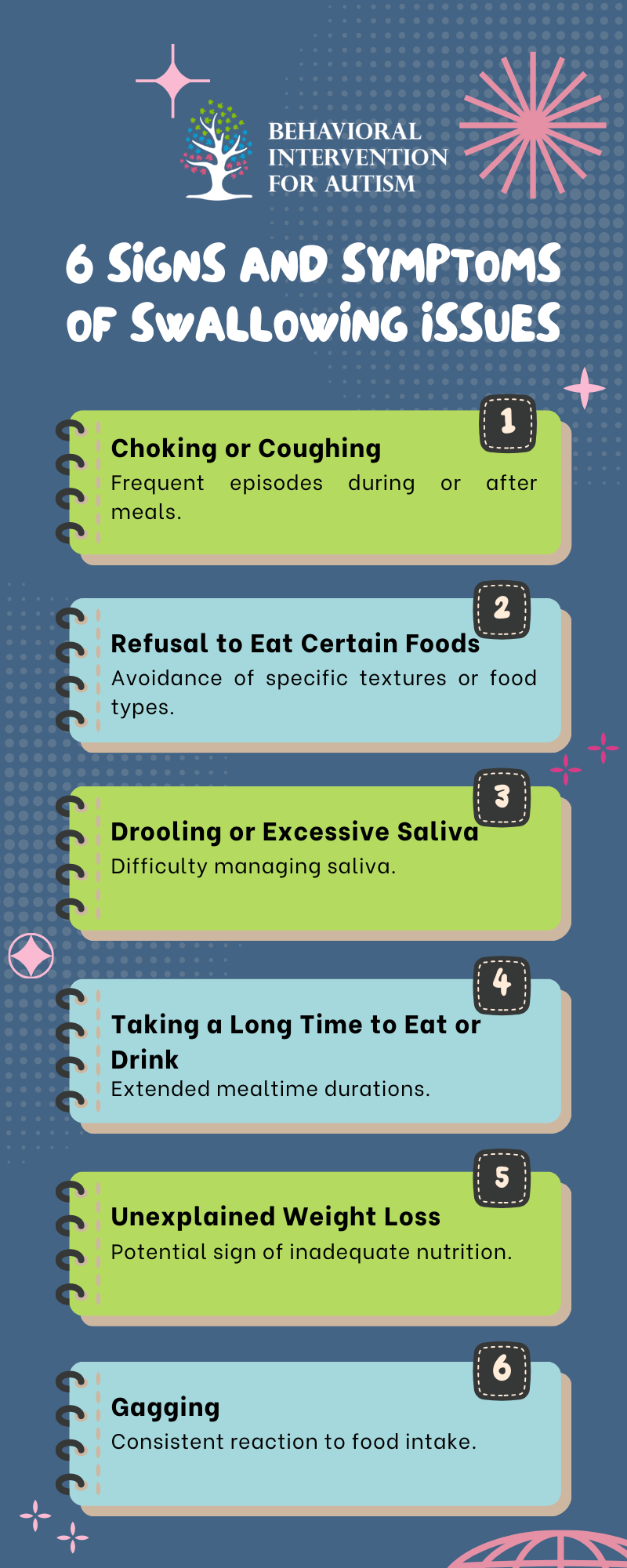
Table of Contents
Autism Spectrum Disorder (ASD) is a developmental condition that affects communication, behavior, and social interaction. Among other challenges, individuals with autism can experience difficulties with feeding and swallowing. These issues, often referred to as food issues, can include selective eating, texture sensitivities, and dysphagia (swallowing problems), which can vary in severity and impact day-to-day life.
Common Swallowing Difficulties in Individuals with Autism
Swallowing difficulties can have a profound impact on an individual’s ability to maintain proper nutrition and overall well-being. Timely recognition and appropriate intervention are crucial in addressing these challenges. To provide a clearer understanding, the following table outlines some of the most common swallowing issues and their prevalence among individuals with autism:
Swallowing Problem | Prevalence (%) |
Chewing Difficulty | 40 – 60% |
Food Refusal | 50 – 70% |
Choking or Coughing | 30 – 50% |
Drooling | 20 – 30% |
Holding Food in Mouth | 25 – 45% |
Addressing swallowing difficulties involves understanding the unique needs of each individual. Caregivers and professionals can work together to create a supportive environment, employing various strategies and interventions tailored to the person’s specific requirements.
Identifying Swallowing Problems in Autism
Understanding and identifying swallowing problems in individuals with autism is a critical step in ensuring their well-being and development.
6 Signs and Symptoms of Swallowing Issues
Swallowing difficulties, also known as dysphagia, can manifest in a variety of ways, and it’s important to recognize these signs early. Early detection can help ensure timely intervention, which can significantly improve outcomes. Below are some common indicators that may signal swallowing issues:

Importance of Early Detection and Intervention
Early identification of swallowing difficulties plays a crucial role in ensuring better health outcomes. By addressing these issues promptly, it becomes possible to prevent serious complications such as malnutrition, dehydration, and aspiration pneumonia. Additionally, early intervention not only improves an individual’s quality of life but also supports safer eating practices. The following points highlight the key benefits of timely intervention:
- Malnutrition Prevention: Ensures the individual receives adequate nutrients.
- Hydration Maintenance: Proper fluid intake is essential for health.
- Aspiration Pneumonia Risk Reduction: Prevents food or liquid from entering the lungs.
- Quality of Life Improvement: Enhances overall well-being and comfort.
Recognizing the importance of early detection and employing prompt interventions can help manage and mitigate the effects of swallowing challenges in individuals with autism.
2 Factors Contributing to Swallowing Problems
Understanding the underlying factors contributing to swallowing problems in individuals with autism is crucial. Two primary factors, sensory sensitivities and oral aversion, as well as motor coordination challenges, play a significant role in these difficulties.
Sensory Sensitivities and Oral Aversion
Individuals with autism often experience heightened sensory sensitivities, which can significantly impact their ability to swallow. Sensory sensitivities may cause an aversion to certain textures, temperatures, or flavors, making it difficult for them to tolerate a wide range of foods and beverages.
Oral aversion, a specific type of sensory sensitivity, can lead to a refusal to eat or drink certain items due to their sensory properties. This aversion can be linked to previous negative experiences with food, such as choking or gagging, which reinforces the avoidance behavior.
Below is a table illustrating how sensory sensitivities may affect different aspects of swallowing in individuals with autism:
Sensory Sensitivity | Impact on Swallowing |
Texture | Difficulty tolerating certain food textures, leading to selective eating |
Temperature | Aversion to extremely hot or cold foods and drinks |
Flavor | Preference for bland or familiar tastes, rejecting new or strong flavors |
Smell | Overwhelmed by strong food odors, leading to reduced appetite |

Motor Coordination Challenges in Swallowing
Motor coordination difficulties, common in individuals with autism, can also contribute to swallowing problems. These challenges can affect the muscles involved in the swallowing process, making it difficult to coordinate the complex movements required for safe and efficient swallowing.
Some key motor coordination challenges include:
- Oral-Motor Skills: Weakness or lack of coordination in the muscles of the mouth, making it hard to chew and move food effectively.
- Pharyngeal Phase: Difficulty in initiating the swallowing reflex and moving food from the mouth to the throat.
- Esophageal Phase: Problems with the muscle contractions that move food down the esophagus to the stomach.
Recognizing and addressing these factors allows caregivers and professionals to develop effective strategies for helping individuals with autism manage swallowing difficulties.
Strategies for Managing Swallowing Problems
Managing swallowing problems in individuals with autism requires a comprehensive approach, utilizing a multi-disciplinary team and incorporating behavioral and sensory strategies. This ensures that the complex nature of swallowing difficulties is addressed from various angles.
A multi-disciplinary approach involves professionals such as speech-language pathologists, occupational therapists, dietitians, and medical specialists. Each professional contributes their expertise to create a personalized treatment plan. Speech-language pathologists focus on swallowing function, while occupational therapists work on fine motor and sensory integration skills. Dietitians design nutritional plans with modified textures, and medical professionals address underlying conditions affecting swallowing.
Behavioral interventions play a key role in addressing eating challenges. Positive reinforcement encourages desired behaviors, gradual exposure helps reduce food aversions, and modeling promotes healthy eating habits. Sensory strategies, such as desensitization and oral-motor exercises, aim to reduce food sensitivities and strengthen the muscles needed for safe swallowing. Sensory integration therapy also aids in processing sensory information related to eating.
Integrating these approaches helps individuals with autism improve swallowing abilities and overall nutrition, enhancing their eating experience and quality of life. Tailored interventions effectively support managing these challenges and promoting well-being.
Dietary Considerations for Autism and Swallowing
Texture Modification and Food Consistency
When addressing swallowing difficulties in individuals with autism, it’s essential to adjust food textures to match their specific needs. These modifications not only prevent choking but also make mealtimes safer and more comfortable. Below is a guide to different food textures that can be tailored to suit the individual’s swallowing abilities:
Food Texture | Description |
Pureed | Smooth and free of lumps, similar to baby food. |
Minced and Moist | Finely chopped and moist, easy to chew and swallow. |
Soft and Bite-Sized | Soft and easy to chew, cut into small, manageable pieces. |
Regular | No modifications, suitable for individuals with no swallowing difficulties. |
To ensure safe swallowing, texture modification plays a crucial role, particularly when it comes to adjusting liquid consistencies. By altering the thickness of liquids, we can help reduce the risk of aspiration, making swallowing safer for individuals with specific needs. Below is a breakdown of different liquid consistencies that may be recommended depending on an individual’s swallowing abilities:
Liquid Consistency | Description |
Thin | Regular water, juice, or milk consistency. |
Nectar-Thick | Slightly thicker than water, similar to nectar or syrup. |
Honey-Thick | More viscous, resembling the thickness of honey. |
Pudding-Thick | Very thick, spoonable, similar to pudding or custard. |

Importance of Proper Nutrition and Hydration
To support individuals with autism and swallowing difficulties, it is crucial to focus on proper nutrition and hydration. A well-balanced diet not only helps meet nutritional needs but also promotes overall health and well-being. To make sure all essential nutrients are included, a variety of foods from different food groups should be incorporated. Below is a list of key nutrients and their recommended sources to help guide dietary choices:
Nutrient | Recommended Sources |
Protein | Lean meats, eggs, dairy products, legumes. |
Carbohydrates | Whole grains, fruits, vegetables. |
Fats | Avocado, nuts, seeds, olive oil. |
Vitamins & Minerals | Fruits, vegetables, fortified foods. |
In addition to maintaining a balanced diet, ensuring proper hydration is crucial for overall health. Monitoring fluid intake can help prevent dehydration and promote optimal bodily function. The following is a breakdown of the recommended daily fluid intake for various age groups to guide you in making sure hydration needs are met:
Daily Fluid Intake | Recommended Amount |
Children (4-8 years) | 5 cups (1.2 liters) |
Boys (9-13 years) | 8 cups (1.9 liters) |
Girls (9-13 years) | 7 cups (1.6 liters) |
Boys (14-18 years) | 11 cups (2.6 liters) |
Girls (14-18 years) | 8 cups (1.9 liters) |
Adults | 9-13 cups (2.1-3 liters) |
It’s beneficial to work with a dietitian or healthcare provider to create a meal plan that accommodates the individual’s dietary needs while also considering their swallowing capabilities.
Find Effective Solutions for Swallowing Issues in Autism
Swallowing problems are common among individuals with autism, often resulting from sensory sensitivities or difficulties with motor coordination. These challenges can affect eating habits and overall nutrition, but with the right support, progress is possible. Behavioral Intervention For Autism offers specialized ABA therapy in Florida, focusing on individualized strategies to address such concerns. Our experienced team works closely with each person to create personalized interventions that support their unique needs and help them overcome obstacles related to swallowing. If you or a loved one is experiencing difficulties, we’re here to help—reach out to us today to discover how we can assist in making daily tasks easier.
- 9 Common Obsessions of Children With Autism You Should Know - February 25, 2025
- What is Neurodiversity? A Guide to Embracing Differences - February 25, 2025
- Understanding Hyperfocus in Autism: What It Means and Why It Happens - February 25, 2025
